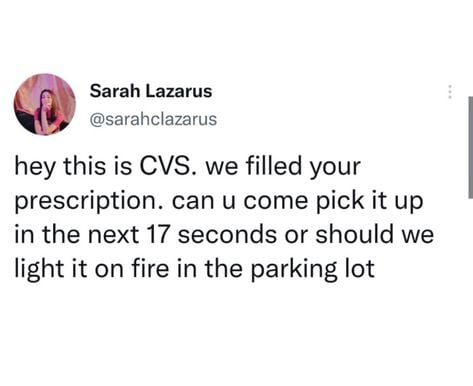this post was submitted on 25 Jun 2024
586 points (98.0% liked)
People Twitter
5220 readers
2437 users here now
People tweeting stuff. We allow tweets from anyone.
RULES:
- Mark NSFW content.
- No doxxing people.
- Must be a tweet or similar
- No bullying or international politcs
- Be excellent to each other.
founded 1 year ago
MODERATORS
you are viewing a single comment's thread
view the rest of the comments
view the rest of the comments

I have worked in a CVS so I can answer this first hand. The main reason is every CVS is critically understaffed to the point of danger to patients.
Beyond that systemic problem that adds delay, actually dispensing the prescription is not the rate limiting step. When you get a prescription there's a whole list of things you need to do before it can be dispensed. In no particular order:
If it's a controlled substance you need the pharmacist to do about 50% of the steps above and access the safe which is a whole process. In the meantime they are on the phone with a doctor or some insurance trying to get something clarified or approved. Or compounding someone's diaper cream. Or doing vaccinations. Or counseling someone on their antibiotic. Some drugs have mandatory monitoring programs you have to enter information from the doctor before they can be dispensed. Some drugs require a dosage syringe, or intramuscular syringes, or needle tips.
Suffice it to to say it is an involved process.
Wow, that is a lot more manual work than I expected. You have to rewrite the directions too? I imagined the prescribing doctor would do that, then all you have to do is look up the order on the computer and print out the label.
Thank you for the explanation, the whole process seems like it could be made more efficient.
Last prescription I got was antibiotics and steroids for an ear infection. The doctor indeed did give me dosage and schedule. Then the pharmacy also gave me instructions, and they were different. Seeing how each Doctor hopefully keeps up with their field and most likely can't really with others, I'd say the pharmacy instructions are usually safer unless the patient has specific circumstances only the prescribing doctor is aware of.
Sometimes the doctor will write something in latin abbreviations so you have to translate that and write it out in plain text but you typically want to make sure the entire directions can fit on a single label. If you just say "see attached directions" then you may not get paid for the prescription if their insurance audits it they will take back any payment they gave to the pharmacy because you dispensed incorrectly. They may also just write something unhelpful like, "as directed in discharge paperwork" or "to be dosed by pharmacy" or something really long that can't easily fit.
That said it's been several years since i have been there so there may have been more enhancements.